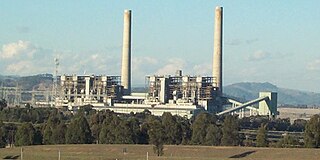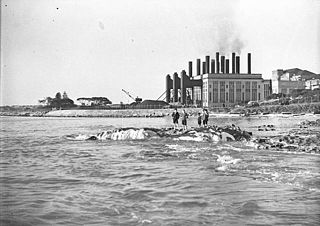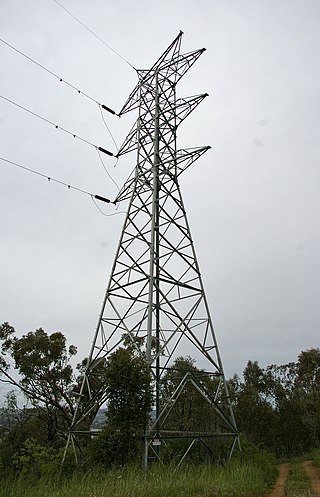
The City of Lake Macquarie is a local government area in the Hunter Region in New South Wales, Australia. It was proclaimed a city from 7 September 1984. The city is situated adjacent to the city of Newcastle and is widely considered as a part of the Greater Newcastle area. The city is approximately 150 km (93 mi) north of Sydney. One of its major tourist attractions is its lake, also named Lake Macquarie.

Origin Energy an ASX listed public company with headquarters in Sydney. It is a major integrated electricity generator, and electricity and natural gas retailer. It operates Australia’s largest coal-fired power station at Lake Macquarie, New South Wales.

The White Bay Power Station is a heritage listed former coal-fired power station on a 38,000 m2 (410,000 sq ft) site in White Bay, in the suburb of Rozelle, 3 km (2 mi) from Sydney in New South Wales, Australia.

Eraring Power Station is a coal-fired power station consisting of four 720 MW Toshiba steam-driven turbo-alternators for a combined capacity of 2,880 MW. The station is located near the township of Dora Creek, on the western shore of Lake Macquarie, New South Wales, Australia and is owned and operated by Origin Energy. It is Australia's largest power station. The plant has two smokestacks rising 200 m (656 ft) in height. It is slated for closure by mid-2025.

Munmorah Power Station is a demolished coal-fired power station with four 350 MW English Electric steam driven turbo-alternators for a combined capacity of 1,400 MW. The station was located near Doyalson, on the shores of Lake Munmorah, New South Wales, Australia and was owned and operated by Delta Electricity, a company owned by the New South Wales Government.

Liddell Power Station is a decommissioned coal-fired thermal power station that had four 500 megawatts (670,000 hp) EE steam driven turbine alternators for a combined electrical capacity of 2,000 megawatts (2,700,000 hp).

Bayswater Power Station is a bituminous (black) coal-powered thermal power station with four 660 megawatts (890,000 hp) Tokyo Shibaura Electric (Japan) steam driven turbo alternators for a combined capacity of 2,640 megawatts (3,540,000 hp). Commissioned between 1985 and 1986, the station is located 16 kilometres (10 mi) from Muswellbrook, and 28 km (17 mi) from Singleton in the Hunter Region of New South Wales, Australia.
Mount Piper Power Station is a coal powered power station with two steam turbines with a combined generating capacity of 1,400 MW of electricity. It is located near Portland, in the Central West of New South Wales, Australia and owned by EnergyAustralia, a subsidiary of CLP Group. On 23 September 2021, it was announced that the closure of the power station is being brought forward from 2042 to 2040 at the latest. The power station employs 250 workers.

Wallerawang Power Station was a thermal coal power station, located near Wallerawang, in the Central Tablelands region of New South Wales, Australia. The power station was equipped with two turbo-alternators of 500 megawatts (670,000 hp) each, supplied by CA Parsons and Company of Newcastle-upon-Tyne, England. Production commenced in May 1957.

Aberthaw Power Station refers to two decommissioned coal-fired and co-fired biomass power stations on the coast of South Wales, near Barry in the Vale of Glamorgan. They were located at Limpert Bay, near the villages of Gileston and West Aberthaw. The most recent power station on the site, Aberthaw B Power Station, co-fired biomass and as of 2008 had a generating capacity of 1,560 megawatts (MW). The power station closed on 31 March 2020.
Eraring Energy was an electricity generation company in Australia that was owned by the Government of New South Wales, and had a portfolio of generating sites using thermal coal, wind, and hydroelectric power. It was sold to Origin Energy in 2013.
Wyee is a small town in Greater Newcastle that is located in the City of Lake Macquarie local government area in the Hunter region of New South Wales, Australia. It is near the M1 Pacific Motorway and has a railway station on NSW TrainLink's Central Coast & Newcastle Line. It had a population of 1,487 in 2001, which significantly increased to 2,588 in 2011, and decreased to 2,406 in 2016. Wyee is considered a shanty town and remains highly unchanged since World War II.

AGL Energy Ltd is an Australian listed public company involved in both the generation and retailing of electricity and gas for residential and commercial use. AGL is Australia's largest electricity generator, and the nation's largest carbon emitter. In 2014, the company had an operated generation capacity of 10,984 MW. The company emitted 42,227,180 Total Scope 1 Emissions in 2019-20 and 40,209,034 t CO2-e in 2020–21. AGL is also a significant investor, owner, and operator, of renewable energy assets.

Wangi Power Station is a heritage-listed former coal-fired power station at Wangi Wangi, City of Lake Macquarie, New South Wales on Lake Macquarie. The power station operated between 1956 and 1986 and supplied electricity to New South Wales. It was once the largest in the state. The 12,000 square-metre building was listed on the New South Wales State Heritage Register on 2 April 1999.
Cockle Creek Power Station was located in Teralba, New South Wales, Australia on the banks of Cockle Creek. The power stationed operated from 11 March 1927 until March 1976.

Bunnerong Power Station was a coal-fired power station in the south-eastern Sydney suburb of Matraville, New South Wales, Australia that was decommissioned by 1975 and subsequently demolished. When the last generating units were commissioned, it was the largest power station in the southern hemisphere, with a capacity of 375 megawatts (MW) from eleven turbo-alternators. It was able to supply up to one third of the state's electricity needs at the time. It remained the most powerful until the completion of Vales Point Power Station in 1966.

The Electricity Commission of New South Wales, sometimes called Elcom, was a statutory authority responsible for electricity generation and its bulk transmission throughout New South Wales, Australia. The commission was established on 22 May 1950 by the Electricity Commission Act 1950 to take control of power generation in the State. The commission acquired the power stations and main transmission lines of the four major supply authorities: Southern Electricity Supply, Sydney County Council, the Department of Railways and the Electric Light and Power Supply Corporation Ltd, known as the Balmain Electric Light Company, to acquire the Balmain Power Station. The commission was responsible for the centralised co-ordination of electricity generation and transmission in the State, and some local councils continued to be distributors of electricity only.
Myuna Colliery is a coal mine at Wangi Wangi, New South Wales, Australia. The colliery was developed to provide coal for the Eraring Power Station, 5 kilometres to the west. The mine started in August 1979, with coal production commencing in 1982. The Wallarah, Great Northern and Fassifern coal seams have been mined using bord and pillar mining methods. Coal is transported to the Eraring Power Station by an overland conveyor system.
Macquarie Generation is an electricity generation company in New South Wales, Australia, owned by AGL Energy, and has a portfolio of generating sites using predominantly thermal coal power. The company now trades as AGL Macquarie and generates electricity for sale under contract.

Abigail Selina Boyd is an Australian politician living on the Central Coast in New South Wales. She has been a member of the New South Wales Legislative Council since 2019, representing the Greens.















